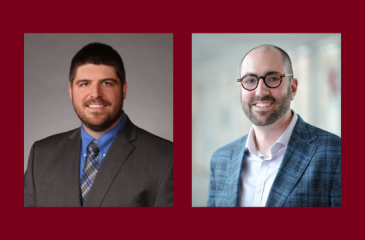This post is part of our "Bioethics in Focus" series featuring experts from the Center for Bioethics community.
Academic small talk often begins by asking, “What is your field of research?” As a Family Physician and Bioethicist, I’ve worked on many different projects over two decades. My answer was becoming lengthy and convoluted - until five years ago. That’s when I began to say, “I study ethical issues in health systems science (HSS).”
What is Health Systems Science (HSS)?
The American Medical Association (AMA) is heavily invested in the concept of HSS, describing it as “a foundational platform and framework for the study and understanding of how care is delivered, how health professionals work together to deliver that care, and how the health system can improve patient care and health care delivery.”1 HSS is our third medical science, following basic science (aka bench science) and clinical science.2 HSS studies the ecosystem of healthcare.
The 12 HSS domains and 18 subdomains3 form the skeleton of my Medical School course curriculum at the University of Minnesota. Coincidentally, they read like a menu of my research interests:
- Ethical issues in quality improvement: for example, performance-based quality improvement incentives such as Pay for Performance (P4P) raise questions like “Who ought to decide which guidelines should be followed?”4, 5 and “Should quality payments to clinics be adjusted for their patients’ social determinants of health?”6, 7, 8
- Systems-based questions about the fundamentals of clinical care reframe traditional topics like informed consent: “Which clinical activities should require informed consent, and which might just require the patient’s assent, or perhaps merely non-dissent?”9
- Shared decision-making has gained popularity over the past two decades. Yet ethical questions remain: “In what way is the decision ‘shared’ if the patient has the final say via informed consent requirements?”19, 20 “What options must the clinician present to the patient – and in what detail?”19-23 and how best to respond to patients that ask, “What would you do in my situation, Doc?”19
- Public health ethics’ interaction with clinical care sometimes raises questions we had never thought to ask. It took an interdisciplinary team to uncover, “What sorts of injuries resulted from using non-lethal crowd control weapons during the George Floyd protests?”10 Our background research and chart reviews further lead us to popularize the term “less-lethal weapons” to replace the less-accurate term “non-lethal weapons."11
- Ethical issues are embedded within our clinic schedules and the Electronic Health Record. We borrowed concepts from behavioral economics to answer the questions “How do clinicians’ practice patterns respond to time pressure?”12 and “How can ‘choice architecture’ and ‘nudge science’ decrease ‘hassle costs’ so that clinicians provide better care?”.13
- Medical education’s interaction with the healthcare system raises ethical questions about the proper scope of Resident and Medical Student contributions to patient care: “How exactly should Residents be supervised?”14 “Should Residents on hospital rounds ‘copy-forward’ their daily notes?”15 “Should we be able to use a Medical Student’s clinical note for billing?”16 Adding an ethical analysis to compliance questions like these can change the course of healthcare in unexpected ways.
- Specialties like Sports-Medicine raise important ethical questions about a physician’s role in society: “Why shouldn’t you cheer for your high school team if you are the sideline physician?”17 “As a team physician, must you warn your players that you are not their personal physician – and that your primary allegiance is to the health of the team?”17, 18
How are the ethics of HSS new?
At the border between ecosystems, where desert becomes forest, or jungle becomes grassland, the greatest biodiversity flourishes. So too, traditional fields of moral inquiry, like clinical care and public health, reveal new questions at the intersection of their borders. By understanding HSS as the third medical science, the issues at the intersections cease to be the fringe research of each field. Indeed, HSS ethics can contribute most by centering its work at the ecological edges between traditional fields of medical study.
What’s in a name?
Naming things can be useful. Despite having conducted research squarely within HSS for two decades, I’ve only recently been able to see the full scope of what I’ve been doing – and what many of us are doing. I recently met with one of our national leaders of HSS at the AMA. I hold him in high regard, and he knows all the major players in this emerging field. I asked him in private, hoping to make research connections of my own, “who works on the ethics of HSS?” After a lengthy pause (over zoom), he scratched his head and asked, “what do you mean?” I told him the same story that you have just read. It was my best account to date and formed the basis of this essay. He thought some more and eventually replied, “I guess you do.”
How should we move forward?
The ethics of HSS, like HSS itself, is an emerging field. It is academically ripe. I encourage academics to look through its lens to discover the neglected issues plaguing our healthcare system for decades. I call on clinicians and healthcare leaders to name and address the issues that arise in their clinical and business practices. I ask medical educators to simultaneously learn and teach about these issues. Patients, too, can be key players. By asking the right questions, everyone can participate in this cultural revolution of Health Systems Science.
References
- https://www.ama-assn.org/topics/health-systems-science (accessed 2/13/23)
- Skochelak S.E. Editor. (2020) Health Systems Science: AMA Education Consortium, 2nd Ed Elsevier.
- Gonzalo JD, Chang A, Dekhtyar M, Starr SR, Holmboe E, Wolpaw DR. Health Systems Science in Medical Education: Unifying the Components to Catalyze Transformation. Academic Medicine 95(9):p 1362-1372, September 2020.
- Culhane-Pera KA, Pergament SL, Kasouaher MY, Pattock AM, Dhore N, Kaigama CN, Alison M, Scandrett M, Thao MS, Satin DJ. Diverse Community Leaders’ Perspectives about Quality Primary Healthcare and Healthcare Measurement: Qualitative Community-based Participatory Research. Int J Equity Health. Oct 2021, 18;20(1):226.
- Culhane-Pera KA, Ortega LM, Thao MS, Pergament SL, Pattock AM, Ogawa LS, Scandrett M, Satin DJ. Primary care clinicians' perspectives about quality measurements in safety-net clinics and non-safety-net clinics. Int J Equity Health. 2018 Nov 7;17(1):161.
- Conway A, Satin DJ. The role of pay-for-performance in reducing healthcare disparities: A narrative literature review, Preventive Medicine, November 2022, Volume 164.
- Satin DJ. The Impact of Pay for Performance on Health and Healthcare Disparities, Keynote at the Congressional Black Caucus Healthcare Braintrust / National Minorities Quality Forum 6th Annual Leadership Summit. Washington DC, April 27-28, 2009.
- Satin DJ. Paying Physicians and Protecting the Poor: Pay for Performance systems should protect the health of poor patients and level the playing field for the physicians who treat them. Minnesota Medicine, April 2006;89(4):42-44.
- Tunzi M, Satin DJ, Day PG. The Consent Continuum: A New Model of Consent, Assent, and Nondissent for Primary Care, Hastings Center Report. 51, 2 (2021) Mar/Apr.
- Kaske EA, Cramer SW, Pena Pino I, Do TH, Ladd BM, Sturtevant DT, Ahmadi A, Taha B, Freeman D, Wu JT, Cunningham BA, Hardeman RR, Satin DJ, Darrow DP. Injuries from Less-lethal Weapons during the George Floyd Protests in Minneapolis. N Engl J Med. 2021 Feb 25;384(8):774-775.
- Kaske EA, Wu JT, Hardeman RR, Darrow DP, Satin DJ. The Language of Less-Lethal Weapons. The Proceedings of the National Academy of Sciences, April 2022. Vol. 119, No. 17.
- Freedman S, Golberstein E, Huang TY, Satin DJ, Smith LB. Docs with their Eyes on the Clock? The Effect of Time Pressures on Primary Care Productivity. Journal of Health Economics. 2021 May 23;77:102442.
- Neprash HT, Vock DM, Hanson A, Elert B, Hort S, Karaca-Mandic P, Rothman A, Melton GB, Satin D, Markowitz R, Golberstein E. Effect of Integrating Access to a Prescription Drug Monitoring Program Within the Electronic Health Record on the Frequency of Queries by Primary Care Clinicians: A Cluster Randomized Clinical Trial. JAMA Health Forum. June 2022;3(6):e221852.
- Harper PG, Adam P, Wooten M, Smithson A, Martin C, Carlson S, Pattock AM, Satin DJ. Financial Impact of Universal Precepting in Family Medicine Residency Clinics. Family Medicine. 2020 Jan 4;52(1):24-30. Epub Nov 4. 2019;52(1):24-30.
- Satin DJ. Ethical, Legal, and Policy Issues of Residents Electronic Health Records, Keynote at the American Academy of Neurology Annual Meeting, Clerkship and Program Directors Conference, Vancouver, Canada, April 15, 2016.
- Satin DJ. Ethical, Legal, and Policy Issues of Medical Students Electronic Health Records, Keynote at the American Academy of Neurology Annual Meeting, Clerkship and Program Directors Conference, Vancouver, Canada, April 15, 2016.
- Stovitz SD. Satin DJ. Professionalism and the ethics of the sideline physician. Curr Sports Med Rep. 5(3):120-4, May 2006. (Reprinted 2(1):55-9, March 2007.)
- Satin DJ. Simonson G. Roberts WO. Johnny Tested Positive for COVID-19, What Next for the Team? Curr Sports Med Rep: Dec. 2020; 19(12) 511-513.
- Satin DJ, Swenson S, Stovitz SD, Effectively Engaging Patients in Everyday Health-Care Decisions. The Journal of Family Practice, Oct;66(10), 2017.
- Satin DJ, Tunzi M, Day P. We Don’t Offer What Can’t Be Chosen: Why Harmful Consequences Should Not Be “Decisive” in Assessing Decision-Making, The American Journal of Bioethics, October 2022;(10) 60-62.
- Stovitz SD, Shrier I, Satin DJ. Shared Decision Making Regarding Aspirin in Primary Prevention of Cardiovascular Disease (Comment). JAMA, December 6, 2016; Volume 316, Number 21.
- Satin DJ. More Realism About Informed Consent. The Journal of Laboratory and Clinical Medicine. 2005;145:292-4.
- Miller JR, Larson BE, Satin D, Schuster L. Information-seeking and decision making preferences among adult orthodontic patients: an elective health care model. Community Dent Oral Epidemiol 2011; 39: 79–86.



